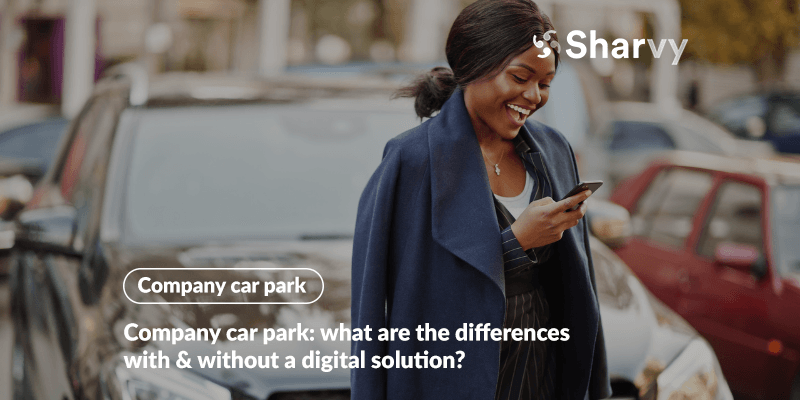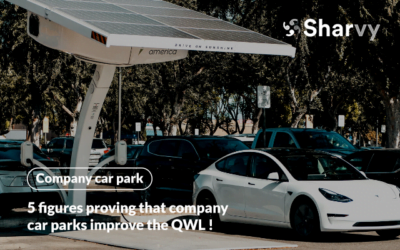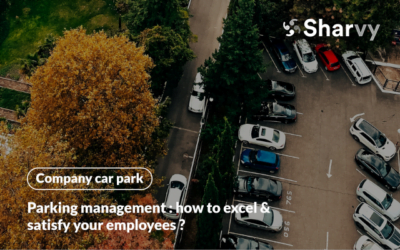It’s 8.30am. You pull into the company car park, coffee still hot in your hand. First turn, nothing. Second turn, still nothing. You spot a free space, but it’s reserved. Meanwhile, the clock is ticking, and your morning meeting is getting dangerously close. Finally, you park outside, already annoyed before you’ve even turned on your computer.
Does this sound familiar? It is for many employees. Behind this morning ritual lie much deeper issues: fairness, organisation, productivity, employer image, etc. Company car park, often perceived as a detail, has a direct impact on the workplace experience.
So should we continue to manage our car parks on a first-come, first-served basis & with reserved spaces that are often empty? Is it not time to adopt digital solutions capable of transforming this point of friction into a real asset? Focus.
Traditional company car park: common problems.
1. An unfair system.
In many companies, not all parking spaces are accessible to everyone. Directors, managers & more senior employees often have a dedicated space, while others don’t even have access to the car park.
This hierarchical distribution fosters a feeling of injustice and favouritism, which is all the more visible when these reserved spaces remain empty: their holders are away on business, teleworking or absent.
In addition, there are cases of abusive behaviour: places intended for visitors, pregnant women and people with reduced mobility are occupied by employees who are not entitled to them. In the absence of controls, everyone does « in their own way », to the detriment of those who really need these specific spaces.
2. A waste of resources.
Another frequent paradox is the lack of parking spaces, even though some of them remain unoccupied.
The reason for this? A rigid organisation in which certain spaces are allocated by name, but the holders are not always present: business trips, teleworking days, days off, etc. Some employees go round in circles and end up with no parking space at all.
Some employees drive in circles and end up car park outside. Not only do they not have access to the spaces, but they also see empty spaces in front of them every day. A traditional management system that is set in stone, wasting a precious resource and accentuating the feeling of inequity.
This phenomenon illustrates a real absurdity : the company has enough spaces, but they are poorly distributed and therefore poorly used.
3. Complicated logistics.
At the same time, welcoming a visitor in these conditions can be a real headache. Without a booking system, or visibility in advance, it’s impossible to know whether a place will be free on the day they arrive. As a result, some visitors find themselves driving in circles, or even worse, having to park outside, which gives a bad impression as soon as they arrive.
This is particularly problematic when it comes to major customers, strategic partners and service providers who are essential to the smooth running of the company.
Management is no easier for in-house teams. Receptionists often have to juggle last-minute requests, telephone calls to « » reserve a place, or even approximate explanations of the location of pitches. In some cases, this also means manually managing access badges, updating Excel files and printing temporary authorisations. These are all small, repetitive tasks that take up time, generate errors and reduce overall efficiency.
4. A poorer user experience.
The problem isn’t limited to the parking spaces themselves: it’s the whole experience that suffers. Searching for a space every morning becomes stressful and distracting, and this stress can affect mood and productivity throughout the day.
And beyond the discomfort, this poor management has a real cost: accumulated delays, delayed meetings, additional stress and tension between colleagues. Micro-conflicts that subtly but permanently affect the working atmosphere.
A car park with these problems reflects a lack of organisation and consideration for employees, degrading both the user experience and the working climate.
Car park with a digital solution: the solutions to these problems.
1. Greater fairness & transparency.
Before : Some spaces were reserved for managers and the most senior employees, while others circled the block, or worse, were denied access to the company car park. Abusive occupancy was frequent, and reserved spaces sometimes remained empty.
What happened next? Thanks to Sharvy’s fair algorithm, spaces are allocated automatically, according to predefined rules. Badges and number plate recognition (LAPI system) control access, ensuring that only authorised vehicles can park. Spaces for visitors, pregnant women and disabled parking space are systematically reserved for the relevant profiles. The result: a feeling of fairness and transparency for all users.
2. Better use of space.
Before : Spaces often remained unoccupied because their holders were away on business, teleworking or on holiday, while other employees had no space available.
After : Real-time monitoring of the occupancy rate means you know which spaces are free at any given time. Vacant spaces can be reallocated automatically, and shared on days when the holder is away. In this way, space is used optimally, reducing the need to expand the car park and ensuring that no-one is looking for a space unnecessarily.
3. Simplified, flexible management.
Before : Welcoming visitors and service providers required manual monitoring of badges, authorisations and availability, leading to potential errors and wasted time for administrative teams.
After : The administrators of the Parking Management solution simply reserve a space on the application for the visitor. They then receive a detailed email containing their space number, a map of the car park to help them find their way around, and all the information they need to ensure that their car park experience goes smoothly. At the same time, car park access priorities can be set by user type, frequency & times. All administrative management is automated, which frees up time and reduces errors.
4. A smooth, stress-free experience.
Before : The car park was often seen as more of a hassle than a service. Employees would start their day by wasting unnecessary time, sometimes ten minutes going in circles. Delays would pile up, meetings would start late, and the mental energy available for work would be depleted before they even walked through the office door. For visitors, having to look for a seat outside or turning up late at reception immediately gave the company a bad image.
What happened next? With a digital solution, parking ceases to be a problem and becomes a seamless service. Employees book their parking space in advance (standard, electric, PRM, bike, motorbike, etc.), receive a notification when a space is allocated, and are guided directly to their parking space using the application and dynamic signs. No more wasted time or energy on arrival: everyone starts their day in good conditions, focused on their tasks.
In conclusion
After all, isn’t car park the first impression you make when you arrive at work? Is it normal that this daily stage still rhymes with stress, wasted time and frustration? Why should we continue to accept an employee driving in circles while there are empty spaces?
What if, instead of being a constraint, car park became a fluid and equitable service? A lever for well-being, productivity and even attractiveness for the company?
In reality, the question is no longer « should you digitise your car park? » but rather: « How much longer are we going to put up with the old reflexes of traditional management? ».
Do you have a question? Have a look at the following FAQ!
Does the digitisation of car park only concern large companies?
No, absolutely not! Even small and medium-sized businesses can benefit from digital management. Even with a small car park, the optimisation of spaces and the transparency of allocation create a calmer climate. In fact, the smaller the car park, the greater the frustration. Consequently, the more visible the impact of a digital solution.
Isn't there a risk that automatic rules will create more rigidity?
On the contrary! Unlike a fixed system « first come, first served » or named spaces, a digital solution introduces flexibility: absences free up spaces, priorities can be adjusted according to need, and everyone knows in advance whether they have a space or not.
How does an employee who has not been offered a place react?
Better than you might think. And why is that? Because with a transparent system, the rules are clear and perceived as fair. Knowing that a seat has been allocated as a priority to a pregnant colleague or an employee with a disability is more readily accepted than discovering empty seats reserved for absent managers every morning.
Want to find out more? Check out our latest articles to keep up to date!
5 figures proving that company car parks improve the QWL!
If you still need to decide about the importance of company car parks, here are 5 figures to prove that they improve the QWL!
Parking Management : how to excel & satisfy your employees?
Discover our 5 tips and recommendations to excel in parking management strategies and satisfy all or some of your employees!
How to optimize the occupancy rate of a company car park?
In this article, we decipher how to analyze & optimize the occupancy rate of your company car park to take advantage of it!
Subscribe to our newsletter!
PARKING & WORKPLACE MANAGEMENT SOLUTION
Car park management - Charging points monitoring - Desk booking - Booking by time slots
SUBSCRIBE TO THE NEWSLETTER
Receive the latest Parking & Workplace trends by email once a month.













